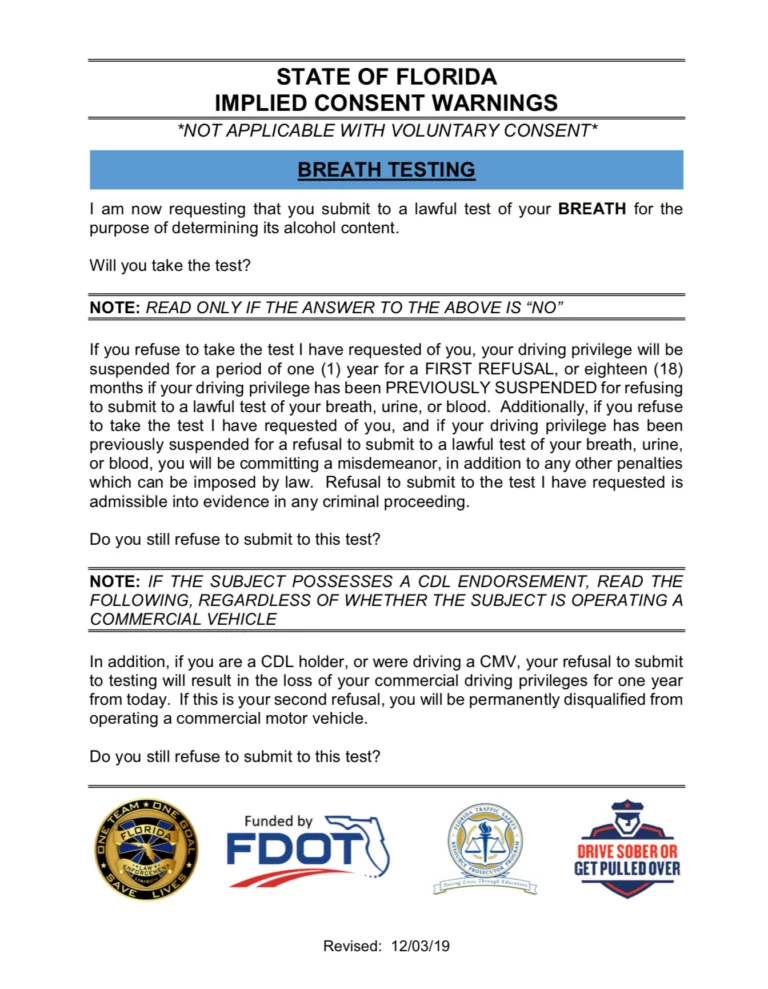DUI Breath Test
Many people believe that if they blow over the legal limit of .08, they will not win their DUI case. In many of these cases, however, a DUI conviction is avoided when the case is dismissed before trial, reduced to reckless driving during plea bargaining, or results in a not guilty verdict at trial.
The results from the “mystical machine” remain the prosecutor’s most persuasive piece of evidence. For this reason, it is important to fight to exclude the breath test results from coming into evidence.
If the breath test results are not excluded on a pre-trial basis, then information gained during an audit becomes very important at trial to show problems with the Intoxilyzer 8000 used in your case.
After an arrest, seek out the services of an experienced attorney focused on fighting breath test cases with the Intoxilyzer 8000.
In Hillsborough County, the vast majority of breath tests involve the same 5 or 6 Intoxilyzer 8000 machines maintained at the Central Breath Testing (CBT) Unit at the Orient Road Jail. The same breath test operators administer the tests. The same HCSO agency inspector maintains the machines.
To fight a breath test case, you need an attorney who is familiar with these machines, the breath test operators, and the agency inspector for the Hillsborough County Sheriff’s Office (HSCO).
Attorney for DUI Breath Test Cases in Tampa, FL
The DUI Defense attorneys at Sammis Law Firm are familiar with the Intoxilyzer 8000 machines used in Hillsborough County. We also understand the standard operating procedures required at the Central Breath Testing (CBT) Unit at the Orient Road Jail.
We appear in court and at the Bureau of Administrative Review Office in Tampa, FL, on Hillsborough Avenue several times a week. As you can see from our published case results, we work hard to get the administrative suspension invalidated at the formal review hearing.
We understand how to challenge the accuracy and reliability of breath test readings on the Intoxilyzer 8000, the only breath test machine currently used statewide in Florida. This machine has serious flaws that can only be truly understood by examining the “source code” of the machine, which the manufacturer has refused to release.
Even though the source code is not available, the problems with the source code can be demonstrated through the electronic data returned by a particular machine or by examining statistics for all the machines used in Florida.
The most common way to get the breath test results excluded at trial is to show that the machine is not in substantial compliance with administrative rules regarding monthly or yearly inspection. To identify these mistakes, we conduct a detailed audit of the Intoxilyzer 8000 machine, examining all discovery and electronic data.
Contact us to discuss your breath test case and ways to fight to have the reading excluded at trial. Especially for DUI breath test cases, experience matters.
Call us at 813-250-0500 to discuss your case.
DUI Breath Test Statistics in Tampa, FL
Recent statistics released by the Tampa Police Department show that after a TPD arrest for DUI, nearly half of those arrested submit to a breath test on the Intoxilyzer 8000. In 2016, for example, 1,058 people submitted to a breath test. Of those, 34 people blew under the legal limit of .08, which is 3.2%.
For individuals who submitted to the breath test and blew over the legal limit, the following BAC range in TPD cases was reported:
- .080-.149 at 21.5%
- .150-.199 at 17.3%
- .200-.249 at 7.4%
- .250-.299 at 2.5%
- .300 or over at .04%
The Tampa Police Department keeps detailed statistics on each DUI enforcement officer. We can examine statistics to determine whether the cases are self-initiated or occur after dispatch.
We can also find out whether a particular officer has a higher-than-average refusal rate (which might demonstrate that the officer has a habit of improperly encouraging subjects to refuse the breath or urine test).
We are familiar with the standard operating procedures used by the Tampa Police Department and the information they keep on each officer. This information is crucial to winning the case at trial or negotiating a more favorable settlement before trial.
Information Center on Breath Testing
- The Common Factual Issues Leading to Breath Test Challenges
- Problems with the Breath Test
- Attacking the Breath Test Machines in Hillsborough County
- Twenty-Minute Observation Period
- Problem with the Breath Test Technician
- Problems with the Intoxilyzer 8000
- FDLE Acknowledges Glitches in the Machine
- How the Inability to Measure Breath Test Volume Makes the Results Unreliable
- Due Process Requires Disclosure of the Source Code
- Reasons Why Production of the Source Code is Necessary
- Resources for Contesting DUI Cases Involving Breath Test Readings
- DUI Attorneys Challenging Breath Tests in DUI Cases
The Common Factual Issues Leading to Breath Test Challenges
The most common factual issues leading to challenges to the breath test under Florida law include:
- The breath test was given prior to the driver being arrested for DUI;
- The officer didn’t have probable cause to lawfully make a DUI arrest or request the breath test;
- The driver took the breath test because the arresting officer gave affirmative misadvice about the consequences of refusing without reading the Implied Consent Warning;
- The driver is advised of the Implied Consent Warning but does not understand it before taking the breath test;
- The driver invoked his right to Miranda and was confused about how his 5th amendment rights impacted implied consent;
- The driver asks for an attorney before deciding whether to take the breath test; or
- The driver asks for an independent blood test, breath test, or urine test.
- The first two breath sample readings are not within .02 agreement;
- The law enforcement officer failed to follow the 20-minute observation rule;
- The driver was told to blow into the machine until told to stop;
- The first two samples did not occur within 15 minutes of each other;
- The driver was wearing dentures which may have caused a high breath test reading;
The breath test reading might also be excluded from trial when the Intoxilyzer 8000 was not in substantial compliance with the administrative rules for any of the following reasons:
- The agency inspector did not report the results of the agency inspection because the inspector backspaced through the exception or error messages during the Alcohol Free / Mouth Alcohol test or during the Interferent Detect test;
- An unauthorized person entered the breath testing room;
- The test result was not within the acceptable range;
- The agency inspected and retested without entering the reason when prompted;
- The agency inspector said the machine was in compliance when it was not;
- The agency inspector started a second agency inspection without contacting FDLE; or
- The agency inspector used tap water instead of distilled water during the monthly inspections.
Problems with the Breath Testing Equipment in Hillsborough County, FL
Problems with breath testing on the Intoxilyzer 8000 used in Hillsborough County, FL, can include:
- Problems with properly calibrating the Intoxilyzer 8000 breath test machines;
- Problems with burping or belching during the 20-minute period before taking the breath test;
- A medical condition that causes a false high reading, including acid reflux or Gastro Esophageal Reflux Disorder (GERD);
- Inaccurately high readings caused by alcohol being trapped in the mouth because of dentures or dental work;
- Grossly inaccurate readings when the person taking the breath test has a body temperature that is slightly higher than normal, which can be caused by a fever, cold, or even during certain stages of a woman’s menstrual cycle; and
- Differences in the subject’s lung function are caused by disease or age.
Attacking the Breath Test Machines in Hillsborough County
The attorneys at the Sammis Law Firm have been involved in litigation to throw out the breath test readings is numerous cases in Hillsborough County, FL. Those motions have included:
- Motion for Production of the Source Code or in the Alternative Motion for Exclusion of Breath Test Results;
- Motion to Suppress the Breath Test Intoxilyzer Results Because of the Failure of the State of Florida to Release the Source Code;
- The legality of the promulgation of the FDLE rules pertaining to the Intoxilyzer 8000 and its use in the State of Florida, including:
- Motion for Inspection giving the right to inspect the interior, electrical, and computer components of the Intoxilyzer 8000, as well as the software and source code for the computer program used in the operation of the instrument and the instrument’s qualitative and quantitative analysis of and calculations of breath alcohol content to ensure that it works in a scientific manner; and
- Whether the FDLE Rules constitute an invalid exercise of delegated legislative authority under Chapter 120 of the Florida Administrative Act;
- Whether the FDLE Rules were properly promulgated;
- Whether the FDLE Rules are scientifically sufficient to ensure reliability;
- Whether the FDLE made “substantial modifications” to the Intoxilyzer 8000;
- Whether it is an approved machine under FDLE rules.
- Motion to Suppress (Throw Out) the Breath Test Machine Because the Intoxilyzer 8000 is not an “approved machine” under Florida law, because the breath test was not actually approved since it was not in compliance with the FDLE Rules.
Many of these motions have been successful in counties throughout Florida, including Sarasota, Orlando, Seminole, Lake, and Monroe County, Florida. Many say it is only a matter of time before judges in Hillsborough County, Florida, take similar positions on the Breath Test Machine, also known as the Intoxilyzer 8000, used in this county.
Contact a DUI attorney in Tampa at the Sammis Law Firm to fight your drunk driving case in Hillsborough County, FL. Call 813-250-0500 to discuss the particular facts of your case directly with a criminal defense attorney.
Did the Officer Actually Observe You For the Full 20 Minutes Before the Test?
Did you know that Rule 11D-8.007 of Florida’s Administrative requires that before the breath test is administered, the arresting officer (or another person designated for this job) “shall reasonably ensure” that the person getting ready to take the breath test has “not taken anything by mouth or has not regurgitated for at least 20 minutes before administering the test.”
This rule must be strictly followed before the results of the breath test can be admitted at trial. How can we prove whether the officer actually watched you during this period? Find out more about how these innovative motions to suppress the breath test results might help you win your DUI case in Tampa, FL.
Click here for an article explaining the Breath Test 20-Minute Observation Rule.
Problems with the Breath Test Technician Telling You to “Blow! Blow! Blow! – Keep Blowing…”
Rule 14 was enacted by the Florida Department of Law Enforcement (FDLE), the breath test technician or law enforcement officer has wide discretion in administering the breath test.
The breath test technician can influence the reading, often causing a falsely high reading simply by telling the person taking the test to blow as much air as they possibly can.
The breath test operator might tell the subject to “Blow, blow, blow, keep blowing…” Many breath test operators are improperly trained to encourage the subject to blow as much air as possible into the machine during each attempt.
The reason this advice is wrong is that the longer the subject blows into the machine, the higher the breath alcohol reading (BAC). The machine only requires 1.1 liters of air. By telling a person to blow this way, the BTO is ensuring that too much air is blown into the machine, which might cause a reading that is exaggerated.
Not only does blowing too much air cause a problem, but the machine is calibrated for an average lung capacity. The statistical data compiled by FDLE for the Intoxilyzer 8000 tests that have occurred on subjects throughout the state show that women charged with DUI typically blow less air into the machine because their lung capacity is smaller than a man’s lung capacity.
If the person taking the test is older (particularly over the age of 65), the statistics show that the subject blows less air into the machine. Even though women and elderly people might blow less air, because of a small lung capacity, they are blowing a larger percentage of the available air in their lungs, which also exaggerates the reading.
Encouraging the subject to blow more air than is required can greatly affect the breath test reading, especially for individuals with a smaller lung capacity. One DUI expert, A.W. Jones, on the general issues surrounding the longer, harder blow explained the phenomenon this way:
The subject’s manner and mode of breathing just prior to providing breath for analysis can significantly alter the concentration of alcohol in the resulting exhalation. Hyperventilation lowers the breath alcohol concentration by as much as 20% compared with a single moderate inhalation and forced exhalation used as control tests. Holding your breath for a short time (20 seconds) before exhalation increases the alcohol concentration in exhaled air by 15%.
JONES, A. W., “Blood Alcohol Concentration, Measures of.” Encyclopedia of Drugs, Alcohol, and Addictive Behavior. The Gale Group Inc. 2001. Encyclopedia.com. 3 Dec. 2009.
Problems with the Breath Test Machine – Intoxilyzer 8000
Throughout the State of Florida, DUI defense attorneys are demanding that the State of Florida provide the source code or the software program approved for use in 11D-8.003, along with the production of the source code or the software of the Intoxilyzer 8000 used in this case.
Without the production of the source code, the Intoxilyzer 8000 machine is no more than a “mystical machine” used to establish the Defendant’s guilt. See State v. Muldowny, 871 So.2d 911 (Florida 5th DCA 2004).
The FDLE has not made a request of C.M.I. to produce the source code for its inspection. However, the purchase agreement between the State of Florida and C.M.I. regarding the Intoxilyzer 8000 provides that the State of Florida owns the version of the source code and software for the Intoxilyzer 8000 that was developed specifically for Florida.
Representatives for C.M.I. have stated that the source code consists of approximately 50,000 lines of computer code written in assembly language. Without the source code, the Defendant is unable to question and test the accuracy of the operations of the Intoxilyzer 8000 as well as the “fail-safe” provisions in the computer program.
Without this information, due process rights are violated if the defendant is not given a sufficient opportunity to contest the test results.
The Intoxilyzer 8000, in order to produce a breath alcohol level reading, utilizes a computer program, versions of which range from 8100.08 to 8100.27. One of the machines used in central booking at the Hillsborough County Sheriff’s Office is 80-003388 which contains software version 8100.27.
The manufacturer of the machine alleges that certain “fail-safe” procedures were designed to flag malfunctions of the Intoxilyzer 8000, which are contained in and performed by the computer program contained within the machine. Without this computer program, the machine will not operate.
The FDLE allegedly approved software versions 8100.09 and 8100.10 in the 2002 version of FDLE Rule 11D-8.003. Since that time, there have been approximately 17 subsequent software revisions, one of which is the software version 8100.27, contained within the machine in Tampa found at the central booking of the Hillsborough County Sheriff’s Office.
FDLE Acknowledges Glitches in the Machine
In a letter dated October 5, 2006, the FDLE admitted it had discovered software flaws that allowed scientifically unreliable breath test results to be reported by the machine as scientifically reliable. The software flaws result from the Intoxilyzer 8000’s ability to measure breath volume on any individual test in which a person blows into the device.
Many criminal defense attorneys involved in DUI litigation in Florida argue that the various inspections performed on the machines are useless and irrelevant because the machines are not designed to measure the accuracy of breath volume when simulators are used to test the accuracy of the machines.
One former FDLE Inspector, Roger Skipper (now the agency inspector for the breath test machines maintained by the Hillsborough County Sheriff’s Office), had admitted in other litigation that the FDLE has made no attempt to use independent instrumentation to determine the accuracy of the value provided on any individual breath test administered by using a person’s breath versus a simulator.
The former FDLE Commissioner Guy Tunnell, in a letter to the President of the Florida Prosecuting Attorney’s Association, dated August 11, 2005, stated:
The Intoxilyzer 8000 requires minimum time, slope, flow, and volume components. Only when those minimally acceptable requirements are met will the breath sample be scientifically reliable and the quantitative result accurately reflect the alcohol concentration circulating in a person’s body.
Volume is the key component in establishing reliability. Where a breath sample does not meet minimum volume requirements, the instrument cannot determine if there are interferents or mouth alcohol present, and cannot ensure that a deep lung breath sample has been obtained.
This explanation for these scientifically unreliable results contradicts actual test results that show that the missing instruction in the software was not the reason for the machine’s inability to properly calculate the breath volume on a given sample.
Instead, there is a computer glitch within the FDLE software that can be pinpointed without examining the source code for the software contained in the machine.
How the Inability to Measure Breath Test Volume Makes the Results Unreliable
One of the safeguards of the machine is the ability to record the volume of each breath. When that breath sample is less than 1.1 liters, the machine should report to the breath test operator the warning “volume not met.”
If that warning is not provided, then the machine should have calculated that the sample volume is greater than 1.1 liters. However, no methodology used by FDLE can verify that the breath volume is accurate for any given breath sample.
For example, by inspecting the records pertaining to the Intoxilyzer 8000, experts have now identified yet another software flaw that allows the machine to produce a breath alcohol level when it reports that no breath volume was submitted for analysis.
The Intoxilyzer 8000 Instrument Specification Sheets provided by C.M.I., the manufacturer of the Intoxilyzer 8000, state that volume measurement accuracy on the machine is plus or minus 10%.
The FDLE and C.M.I. have established an arbitrary and capricious requirement of a breath volume of 1.1 liters of breath in order to have a valid sample. The machine has undergone numerous software changes that affect the analytical portions of the software that have been modified.
Despite the changes to the software, FDLE has not, as required by C.M.I., had the Intoxilyzer 8000 machine recalibrated. Without that recalibration, there is no assurance that the breath test volumes for the breath test device are accurate.
Due Process Requires Disclosure of the Source Code
Due process requires that the person accused have a “sufficient opportunity to question the test results,” which includes making available for testing the breath test machine itself as well as its fail-safe procedures.”Houser v. State, 474 So.2d 1193 (Fla. 1985); Cloe v. State, 613 So.2d 70 (Fla. 4th DCA 1993).
In Houser v. State, supra, the Florida Supreme Court stated that due process is met when:
The breath testing machine, calibrating records, and samples were available to impeach the machine’s reliability, and the defendant had the right to cross-examine the machine operator to expose potential errors in the administration of the test.
Id. at 1195. Furthermore, the Florida Supreme Court in Houser also empowered the defendant to obtain discovery concerning the devices used in testing pursuant to Florida Statutes Section 316.1932(1)(f)(4).
In Cloe v. State, supra, the Fourth District Court of Appeals found that due process was satisfied when “the machine could be tested, the test results were available, and the ‘fail safe’ procedures could be questioned.”
Reasons Why Production of the Source Code Matters
DUI defense attorneys throughout the State of Florida are fighting for the source code of the Intoxilyzer 8000 because, without it, the Defendant cannot determine the following:
- How the software in a particular Intoxilyzer 8000 differs from or has been modified from the original software versions approved by the FDLE in 2002.
- Whether those modifications caused the approved software to have additional flaws or glitches;
- Whether the modification impacts the reliability or operation of the Intoxilyzer 8000;
- Whether the software program itself gives a scientifically reliable result on a human breath sample as opposed to a simulator;
- Whether the changes in the various versions of the code are “substantial;”
- How the “fail-safe” procedures work; and
- The extent to which known and unknown flaws in the program affect the accuracy of the test results.
Suppressing the Coerced Breath Test
What happens if the officer coerces you into submitting to a breath test? If the test was coerced, then the criminal defense attorney should file a motion to suppress the results of the case.
- Bullock v. State, 19 Fla. L. Weekly Supp. 329 (Circuit Court Brevard County 11/17/11) – when the defendant, who was in custody at the police station, was repeatedly asked to take the urine test after the breath test indicated no breath alcohol the defendant was finally told that if he did not submit to a urine test, the police might take him to the hospital for a blood draw, request for urine test was coercive and implied authority the police did not possess. Therefore, the trial erred when denying the motion to suppress the result of the urine test since the defendant’s decision to submit was not voluntary.
- State v. Barto, 20 Fla. L. Weekly Supp. 162 B (County Court for Brevard County 11/5/12) – the court granted a motion to suppress the test results when a trooper ignored the defendant’s request to use the restroom before and during field sobriety exercises and during transportation to the state, and the trooper’s responses to defendant’s requests created the impression that the fastest way to gain access to a restroom was by submitting to a breath test, defendant did not voluntarily consent to field sobriety exercises or breath test.
- State v. Bello, (Miami-Dade County Criminal Traffic Division Case No. 4187-XDK and 9425-GBB 12/13/2010) – the beat test results were suppressed when the officer gave an erroneous opinion or statement that caused the driver to believe she would not be able to obtain a hardship license to drive to work for 12 months if she refused.)
Additional Resources
Expert Testimony from Harley R. Myler on Source Code for the Intoxilyzer 8000 – Read the request made to C.M.I., their response, and an affidavit from an expert witness explaining why disclosure of the source code is relevant and necessary to contest the breath test readings.
Guilty By Machine: The Problem of Source Code Discovery in Florida DUI Prosecutions – This article was published in the Florida Law Review by Charles Short.
DUI Attorneys Challenging Breath Tests in DUI Cases
Recent DUI statistics collected in Florida indicate that in 2009, the state conducted 49,783 breath tests using the Intoxilyzer 8000. Of those breath tests, the average breath alcohol concentration reading was 0.147.
More than 18% of the tests show a breath alcohol reading of 0.08 or less. Approximately 82% of the breath test readings were between 0.08 and 0.20. The remaining 23% of the breath tests showed a reading of over .20. See Intoxilyzer 8000 Subject Tests Statistical Data Review Summary – 2009 Yearly Totals.
It seems to us that one should not have privileges and freedom jeopardized by the results of a mystical machine that is immune from discovery, that inhales breath samples and that produces a report specifying a degree of intoxication. State v. Muldowney, 871 So.2d 911, 913 (Fla. 5th DCA 2004).
When we represent a client with a breath test reading on the Intoxilyzer 8000, we conduct a full audit and look at all of the records on the Intoxilyzer 8000 used in your case.
Those records are uploaded to the FDLE website. By reviewing the records, we can often identify problems that indicate the Intoxilyzer 8000 was not in substantial compliance with statutory and administrative rules.
Contact our attorneys to find out more about how we represent our clients charged with DUI after a high breath test reading.
Our main office is in downtown Tampa in Hillsborough County, FL. Our attorneys also fight DUI breath test cases in New Port Richey in Pasco County, FL. Our second office is located at 7509 Little Road, across from the courthouse at the West Pasco Judicial Center.
We take a scholarly approach to fighting for the exclusion of the breath test results. Call 813-250-0500 to talk with an attorney today.
This article was last updated on Thursday, June 12, 2025.
Free Consultation
Submit this form to request a free and confidential consultation with one of our attorneys.
Our Office Locations
Tampa Office:
Sammis Law Firm, P.A.
1005 N. Marion St.
Tampa, FL 33602
(813) 250-0200
New Port Richey Office:
Sammis Law Firm, P.A.
7509 Little Rd.
New Port Richey, FL 34654
(727) 807-6392
Clearwater Office:
Sammis Law Firm, P.A.
14010 Roosevelt Blvd. #701
Clearwater, FL 33762
(727) 210-7004
Our Attorneys














